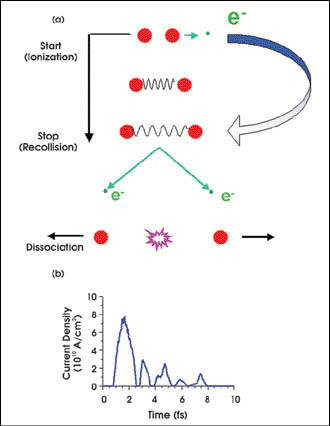
Clock Measures Attosecond Pulses
Kevin Robinson
Scientists at Université de Sherbrooke in Sherbrooke, Quebec, Canada, and at the National Research Council in Ottawa are using double ionization to measure the strength and duration of the attosecond electron pulses created by intense infrared laser radiation. Their work could lead to diffraction imaging methodologies and pump-and-probe techniques for investigating femtosecond chemical changes.

Researchers have developed a technique to measure the attosecond-long electron pulses that are generated when laser radiation doubly ionizes molecular hydrogen. In the double ionization of hydrogen, a freed electron returns to the excited molecule and strips another electron, causing the remaining protons to repel each other (a). The recollision pulse, displayed as the current density experienced by the ion, comprises five subpulses (b). Courtesy of Paul B. Corkum.
When the output of a very intense laser strikes a molecule, it can strip an electron and then force it to return to its parent ion. From the point of view of the ion, these electron pulses occur in the time frame of attoseconds. Researchers have sought a way to accurately measure the strength and duration of the pulses to make use of them.
Paul B. Corkum, the principal investigator on the project, noted that it took scientists nearly a decade to develop a method to measure the strength and duration of an attosecond optical pulse. Fortunately for the group investigating electron pulses, molecular hydrogen provides its own stopwatch.
In the past decade, researchers discovered that a stripped electron is in just the right spot approximately half the time to be driven back into its parent molecule when the lightwave changes its sign. The molecule reacts to this "recollision" as if the electron came from an outside source. The current density, Corkum said, approaches 1011 A/cm2, sufficiently strong to raise another electron to a higher energy level.
When the second electron is stripped away, the protons in the molecule rapidly gain energy as they repel each other. The amount of kinetic energy they gain is related to their distance at the time of the second ionization. Therefore, by measuring the kinetic energy spectra of the dissociated protons with a time-of-flight mass spectrometer, the researchers can tell to high accuracy how far apart they were and when the recollision occurred. "It is easy to distinguish changes in the separation of the atoms by 120 Å or less from the kinetic energy of the protons," Corkum said.
The electron pulse actually contains five subpulses, and the researchers are working to make a single, clean electron pulse. Also, because the pulse length varies with the laser wavelength, they hope to shorten it by decreasing the wavelength of the excitation laser.
"Once we have a single electron pulse, we also believe that we can shrink its duration to well below 1 femtosecond," he said. "We think that 100 attoseconds is possible."
Published: September 2002